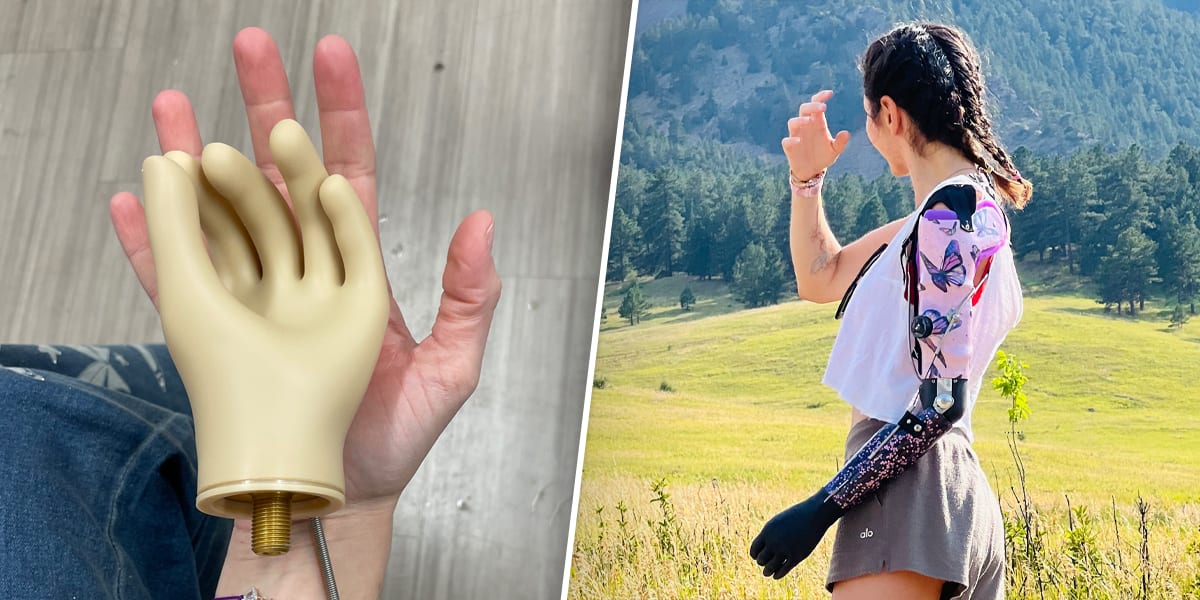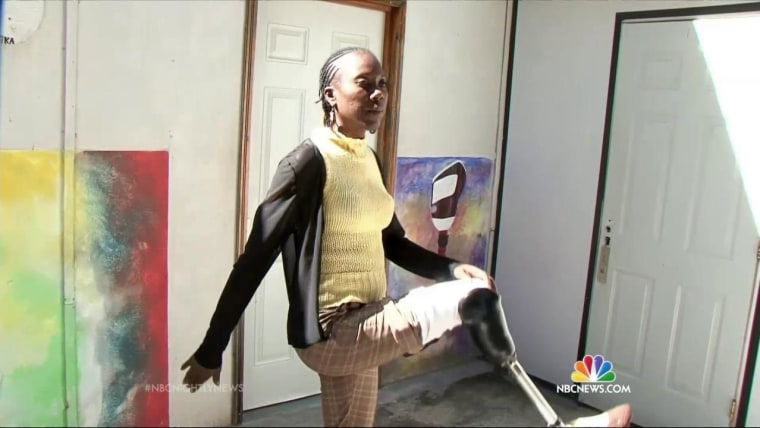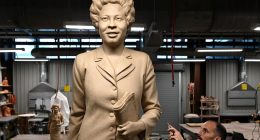Everyone gets angry about the lack of available clothing size diversity, but at least there is such a thing as a size XXXS, 6x, and everything in between and beyond — even if they aren’t always easy to get. You can even get golf ball-size scrunchies to ones the size of the 10-inch Magic 8 Ball (the giant one). But as an amputee, I can’t seem to get a hand that matches the size of the one I have left.
After undergoing a transhumeral (above-elbow) amputation of my left arm in December, I went in for my prosthetic fitting and was shown a tiny hand that fit perfectly in the palm of my own, cute but no cigar. The other choice was one that came in a whopping single size choice — “adult-size” — and a shameful three-skin tone selection.
Ironically, prosthetics, built with disabled users in mind, are still not inclusive, leaving most prosthetic users devoid of the Goldilocks outcome that feels just right.
“You’ll get the woman-size hand,” they reassured me. The only problem is that my hand isn’t “woman sized”— because there’s no such thing. Growing up, the only baseball glove that fit me was a men’s glove because my hands were and still are larger than most women’s, but not as big as the men’s-size hand they also showed me. So, I ended up sticking with the too-tiny women’s hand versus opting for the oversized men’s one, which weighed more. Because prosthetic limbs aren’t actually attached to you like real limbs, they feel heavier in general and adding even more weight to that would’ve made the device difficult to operate.
Ironically, prosthetics, built with disabled users in mind, are still not inclusive, leaving many prosthetic users devoid of the Goldilocks outcome that feels just right. They are meant to be custom-made to fit and balance the wearer’s body, but prosthetics are assembled from parts designed based on a one-size-fits-all standard. The socket (the part of the prosthesis that covers your residual limb) is the only 100% custom portion, leaving many amputees left picking from ready-made selections when it comes to appendages and joints such as hands, feet, knees and elbows. That has never worked on clothing, so why should it be a good idea when re-creating parts of the human body altogether?
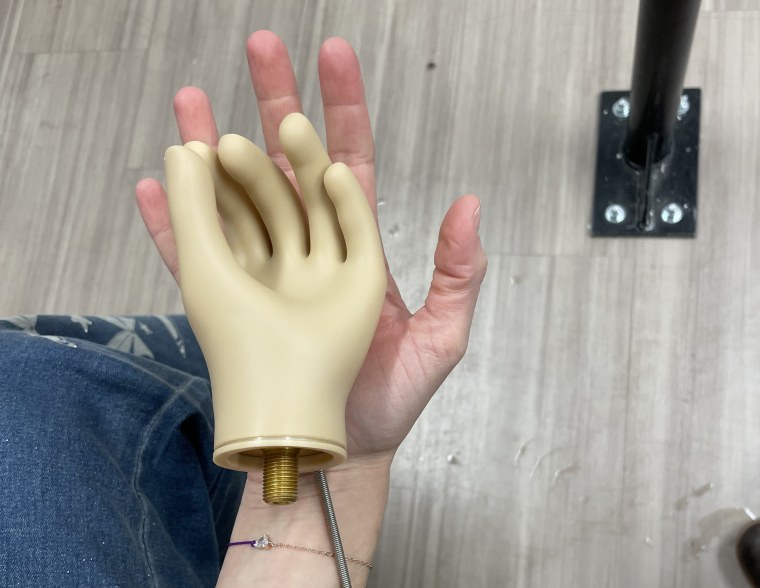
One big contributing factor to the issue is the excessive focus on function. It’s a good goal, but it has spiraled into a mindset that too often has patients choosing function over appearance. Artificial limbs took off trying to reach the functional equivalent of that which Luke Skywalker received in “The Empire Strikes Back.” After Darth Vader severs Luke’s hand, the droids rebuild his arm as a visually-stunning masterpiece indistinguishable from a real arm in both form and function. But the designs in the real world left behind the visual mastery that made Luke’s bionic arm a seamless part of the character.
Sure, it’s a movie, and we have certainly not attained that level of function in a prosthetic limb. But it also highlights that finding a limb with the correct fit aesthetically will significantly contribute to the wearer’s ability to call that device an honest extension of themselves. Whereas right now, the thought is, if it works, then it doesn’t matter if the fit is perfect. Wrong. There are myriad reasons why appearance also contributes to use and function.
To maximize a prosthesis’ function, the user must feel at home in it, both in the actual fit and in their confidence wearing it. I had a preference for a very alienist design from the start, asking for a holographic pink prosthesis and an “Alice in Wonderland” meets “Bridgerton” inspired socket pattern. It never occurred to me to set my sights on a “realistic” prosthesis anyway because the lack of available diversely-sized parts for functional prostheses eliminates that option altogether. Since the hand choices were so limited, I decided to opt for a black-gloved “women’s size” hand versus something that mimicked my skin tone poorly. If it wasn’t going to match in size or color, my best option seemed to lean into the distinction as it was.
The rise of 3-D printing, which offers highly personalized options, has given amputees the best chance of achieving customizable function and fit, but many still cannot access what they need.
The rise of 3-D printing, which offers highly personalized options, has given amputees the best chance of achieving customizable function and fit, but many still cannot access what they need. “The technology itself still hasn’t caught up [on multiple fronts]. A lot of prosthetists still practice old-school techniques and don’t know how to work with 3-D printed parts or even assemble them,” prosthetist and orthotist Zach Harvey, who is certified by the Association of Boards of Certification, told me. Having undergone a special course to learn how to work with these newer approaches to prosthesis construction, Harvey raised the idea that old-school methods of prosthesis-building are a huge catalyst in inhibiting access to the most customized options.
I was working with one of the leading and well-reputed clinics in the U.S. But on numerous occasions, I was not presented with all of my options because it was something my prosthetist was unfamiliar with manipulating. There’s no magic catalog that puts everything that’s out there all in one place for amputees to browse. It’s usually up to providers to work with us, informing us of our options. So if providers don’t catch up with the latest, it’s likely that it won’t become available to their patients.
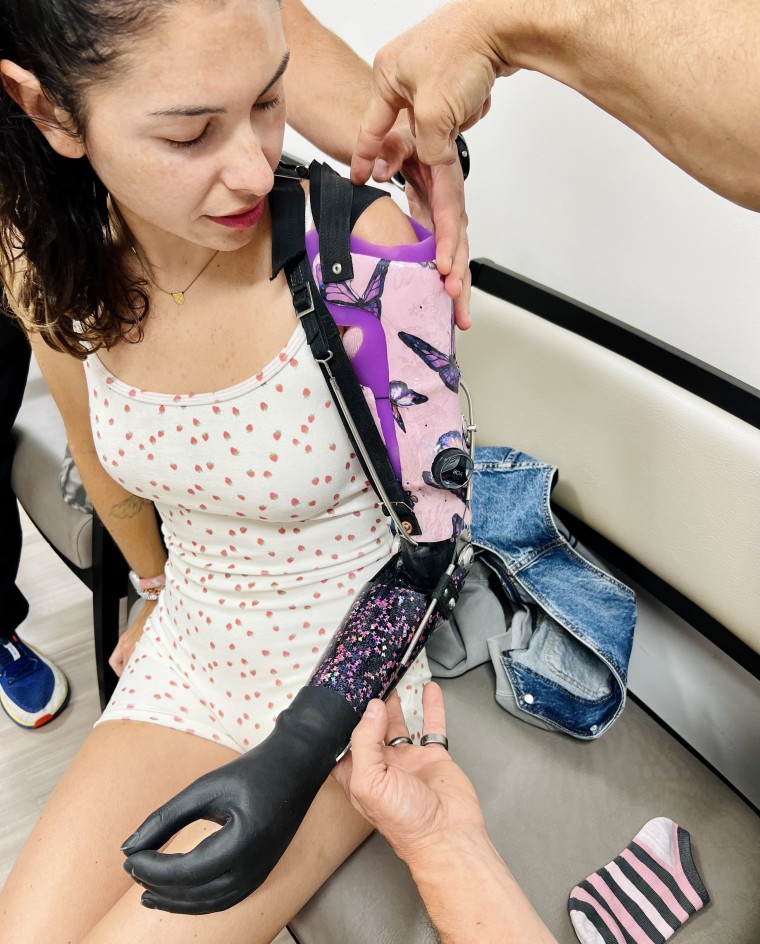
One such option is the TrueLimb, launched in 2020 by Unlimited Tomorrow. Available in any size, shape, and color a patient could need, the TrueLimb is one of today’s top 3-D printed limbs.
To address the lack of diverse sizes in the industry, Easton LaChappelle, founder of Unlimited Tomorrow, came up with a computer program. I spoke to LaChappelle about his approach. It’s one that enables each patient to receive a limb that was scratch made for them, making TrueLimb entirely unique to each buyer.
It works by first scanning the patient’s existing limb (if they have one). This is done via an at-home scan kit that can be done with the help of a friend or family member. Then the scan is sent back to their headquarters, where the limb is printed, assembled, and sent back to the patient.
Using this method, the company can supply limbs to those in need globally. It’s more accessible and doesn’t require any in-person clinician involvement. In other words, clinics that work with traditional methods won’t be needed quite as much. This may create an aversion to informing patients of 3-D printed options such as TrueLimb, again leaving those who qualify unaware of their options.
However, even if access and information regarding 3-D printed limbs were more free-flowing, things aren’t ready to shift over to 3-D printing completely. Because, for now, 3-D printed limbs are mostly directed at upper extremity amputees below the elbow. Some attempts have been made at 3-D printing lower extremity prostheses, but they’ve prioritized low costs without necessarily emphasizing aesthetic accuracy, leaving transhumeral and lower extremity amputees to choose from the pool of existing limb parts coming from today’s forerunning vendors. It’s crucial that these vendors make it a priority to concern themselves with making more diverse parts available.
Now that the once-innovative prosthetic companies have developed molds and set production into motion, they seem reluctant to change their product development methods when it comes to expanding their options for the distal appendages. Some of these vendors are using the methods to produce products such as prosthetic covers and orthotics but have yet to tackle parts such as hands and feet.
And why would they change? Until technologies such as 3-D printing start to master prosthetics for everyone, not just below elbow upper extremity patients, all of the others still have no choice but to opt for what’s already on the market, regardless of total satisfaction on size and aesthetic.
After you lose a limb, it’s important that you find ways to make your life as accessible as possible. When tasks that are meant to be otherwise simple, such as tying your shoes (or even being able to wear your favorite pair) and uncapping a bottle, leave you feeling irritated and incapable before the day has begun, it takes away from other things you want to do. A large part of preventing this type of burnout over the “little things” depends on the tools you use to assist you every day. If those tools don’t fit properly, it becomes harder to function and nearly impossible to feel at home in the technology that is there to quite literally fill in our gaps.
Source: | This article originally belongs to Nbcnews.com


